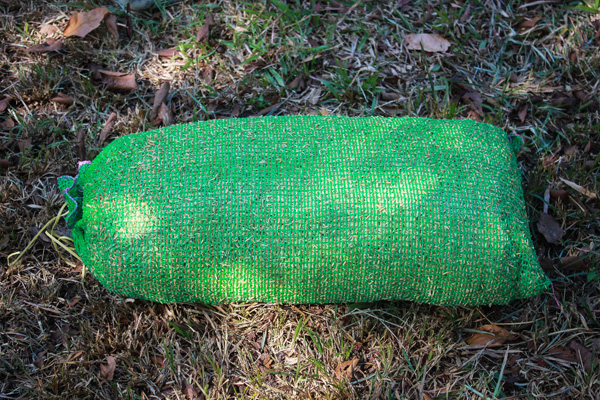
This bit of news is a nice breakthrough for rice hull earthbag building. Using a suggestion from Richard, a long time reader, I made a test bag using raschel mesh and rice hulls. I had previously ruled out using rice hulls in mesh bags, because it seemed certain that the hulls would fall through. Well, it turns out some hulls do fall through, but not many. The hulls naturally jam up against each other and only a negligible amount (say 3% or so) fall through.
The finished size after stuffing the bag full and compressing it by hand is about 7″ high x 13″ x 26″ for this particular brand of raschel bags. The height (thickness) is actually around 7-1/2″, but the weight of other bags will compress it more. A roof load would likely compress it even more.
The tie on the bag end is made from a strip of recycled poly strapping used to secure loads on shipping pallets.
The only downside to these bags is raschel mesh bunches up and so you need a way to hold it open for filling. A bucket chute or feed tube will make it much easier to fill than doing it with bare hands like I did this one.
So there you have it – another step forward for utilizing rice hulls to build lightweight, inexpensive, superinsulated walls. Search our blog for numerous articles about raschel bags and building with rice hulls. Here are two to get you started.
Interview with Maggi of Chiang Dao B&B Rice Hull Houses
Production Earthbag Building Using Rice Hulls (you can use a machine to blow rice hull insulation)

If it is possible to connect me to Mike in TX I would appreciate that. I am also in TX and just starting my research I would love to find out what he learned and if he needs help on a build.
One small disadvantage of rice hull bags: you can’t walk on the walls. You need a ladder or scaffolding.
Rigidity of walls: add some saplings or small bamboo poles on both sides and tie them together with twine.
From Richard: “I believe the lightweight rice hulls would allow for many applications that are impossible for traditional earthbags.”
He send me this pic of a yurt on stilts as an example:
http://2le0xp15a8jj172v473v3y381vh.wpengine.netdna-cdn.com/yurts/wp-content/uploads/sites/2/2014/03/yurt-on-stilts.jpg
Owen I did look over Maggie’s round house carefully and noticed she is using flour sacks made of cotton fabric..so most any type of bag will work..
What do you think about size ..hers are 4-5 meters ..can I go larger?
Flour sacks? Thanks, I didn’t know that. Yes, you can go larger with her building system. One limitation though is how you build the roof.
https://www.facebook.com/video.php?v=335657953158512&l=8650839621268448826
Looks good, thanks.
Here’s a video from 3 years or so ago about raschel mesh bags. It turns out we paid 1/4 the cost of poly bags as Richard was telling me.
One glitch in the video: I’ve since learned that pinning corners of mesh bags isn’t necessary, at least on the ones we’re using.
https://www.youtube.com/watch?v=TKJ6tbPWWUc
Consider building some simple guides to keep the walls flat and vertical. See this pic of the bamboo guides we used on our pantry (worked great, super cheap and easy to build):
https://naturalbuildingblog.siterubix.com/wp-content/uploads/2011/04/laying-mesh-earthbags-sm.jpg
Guides like this could be used on roundhouses. You don’t need corners.
Dr Geiger:
Has any body tried replacing the straw in in Patti Stouter’s natural fiber tube with rice husks?
-wasim
Not sure. Drop her an email and ask.
Your comment made me realize mesh tubes could be made with natural fibers such as hemp. Has anyone heard of this???
Can you use rice sacks ? Or do you need this type of bag so it can breathe?
Both will work. But mesh bags are half price here. Richard apparently found some at 1/4 cost. Plus, plaster sticks much more readily to the mesh, making plastering easier and more enjoyable.
What is the weight of filled bag, please? Thanks!
About the weight of popcorn. And the cost is negligible as well. Some places give the hulls away. Here, it’s about $50 – $75 for half a semi truck load delivered.
Can the rice hull bags walls be load bearing or can it only work with a post and beam structure? How would stucco be applied? The insulation properties are very tempting but the dangers of moisture infiltration compromising the wall is the biggest deterrent.
In most instances a post and beam frame would make the most sense. See Maggi’s B&B blog for one excellent example. It doesn’t have to be elaborate or expensive. Richard is contemplating small loadbearing roundhouses without posts.
Use standard plastering methods. Plaster sticks to the mesh like super glue. It is the IDEAL surface for plastering. I just laughed when I first tried it. The bonding is almost too good to be true.
Moisture: Use the same methods as established for strawbale building (which is extremely common and now in the building code). Build a durable roof with wide roof overhang, and raise the rice hull bags above the splash line and snow level. Wrap-around porches would be ideal. That way the walls would never get wet. But no need to get worried about a little moisture. Maggi is building domed roofs in Thailand! Talk about pushing the limits. But it’s good that someone is exploring the boundaries of what’s possible. Maybe she has to replace her $400 roof in 10 years. Pfft. No big deal.
This jogged my memory. I have an old, old roundhouse design using rice hulls and wrap-around porch. I’ll try to find it.
Owen, did you find that roundhouse design using rice hull and the porch? sounds interesting!
As you may know, Owen has been ill and unable to answer emails for a couple of months. I have taken over the blog and have access to his plans. The only roundhouse with a porch that I could find is at http://dreamgreenhomes.com/plans/roundhouseyurt.html